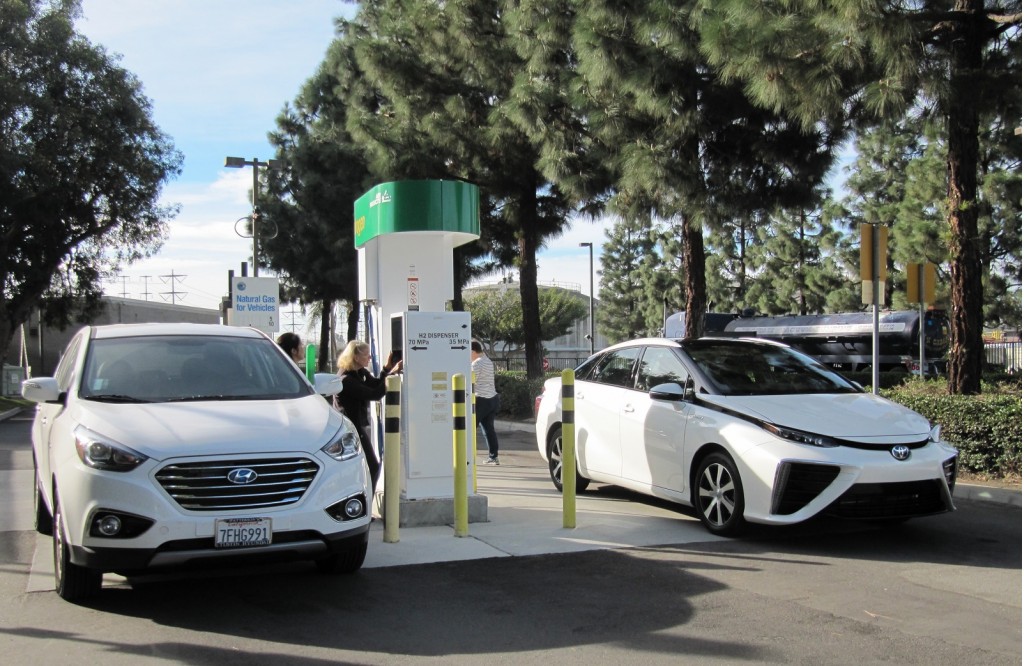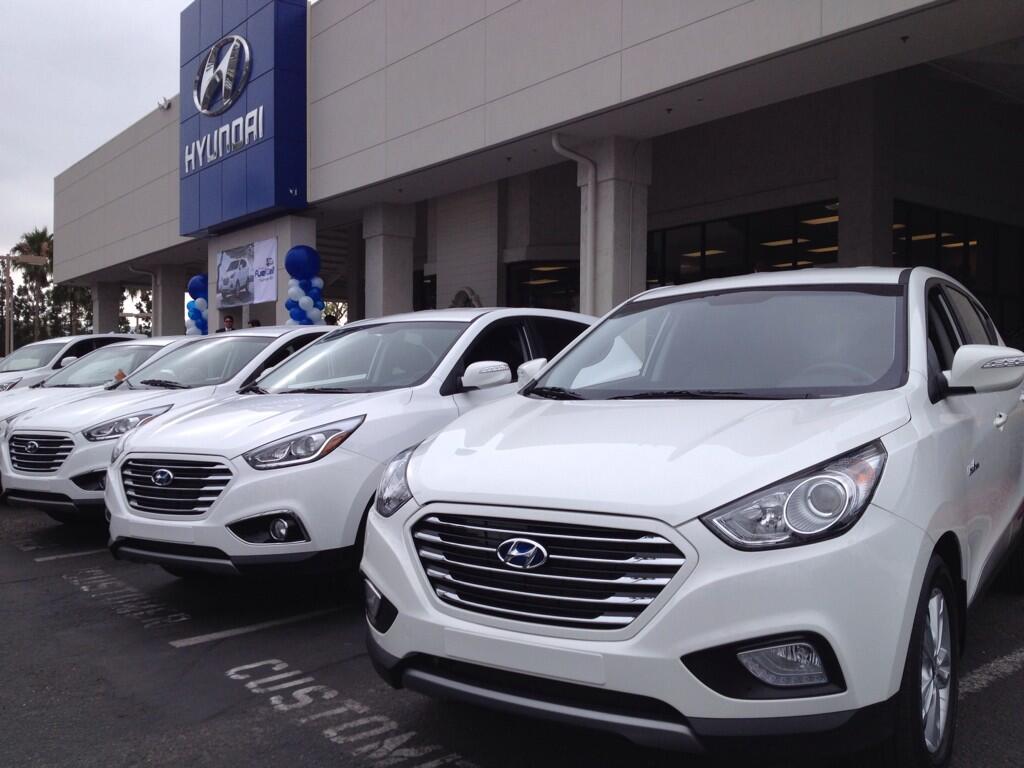While they enjoy driving their cars, early lessees of hydrogen fuel-cell vehicles in Southern California are complaining that they can't reliably fuel them at the handful of stations now supposedly operating in their region.
The stations are frequently inoperative, they say, closed for days or weeks at a time.
Moreover, when the stations are functioning properly, they sometimes can only fuel one or two cars before an hour-long wait is required--and some stations can only fuel the cars to half-full.
DON'T MISS: Hyundai Tucson Fuel Cell: Early Drivers Discuss Experiences Traveling On Hydrogen
A private Facebook group for drivers of the Hyundai Tucson Fuel Cell SUV overflows with complaints about these issues, and the lack of accountability among the several different parties who oversee pieces of the nascent hydrogen fueling infrastructure.
[UPDATE: Green Car Reports received a statement from the California Air Resources Board on Friday, which we have appended to this story at the end of page 2.]

2015 Hyundai Tucson Fuel Cell at hydrogen fueling station, Fountain Valley, CA
Hyundai includes unlimited free hydrogen fuel as part of its $499 monthly lease cost (with $3,000 due at signing).
But neither Hyundai nor Toyota, which is in the process of launching its hydrogen-powered 2016 Mirai, is responsible for providing the fuel or ensuring a functioning infrastructure.
Instead, that task falls to a variety of organizations that own or operate the stations.
Contacted by Green Car Reports, Hyundai spokesman Derek Joyce deferred questions on fueling infrastructure for hydrogen vehicles to a representative from the California Governor's office.
(If we receive a statement from that office on the progress of Southern California's hydrogen fueling infrastructure, we'll update this article.)
Last year, the state of California committed $100 million over five years to building 100 hydrogen fueling stations in the state by 2020, in partnership with Toyota, Hyundai, and Honda, and private companies like First Element Fuel as well.
Early lessee Paul Berkman of Corona del Mar, for one, is frustrated.
He's paying $500 a month for a vehicle he hasn't been able to drive for five weeks, because all three hydrogen stations within 20 minutes of his home or workplace have been down for more than a month.
ALSO SEE: 2015 Hyundai Tucson Fuel Cell: Hydrogen Crossover First Drive (Dec 2013)
Berkman told Green Car Reports that the closest station, five minutes away at a Shell site in Newport Beach, has been "struggling"--and that at best it can only fill his Tucson Fuel Cell to half capacity.
Ten minutes away, a station by the University of California--Irvine campus has been closed for upgrades.

2016 Toyota Mirai hydrogen fuel-cell car, Newport Beach, CA, Nov 2014
Other fuel-cell drivers, he said, told him that station "really suffered" from demand, with occasional lines of one or more drivers waiting for it to come up to pressure so they could refuel.
And a model "tri-cycle" station in Fountain Valley, about 15 minutes from his home--which used methane from buried trash as a feedstock, lowering its carbon footprint--has now been shuttered for almost five months, he said.
MORE: 10 Questions On Hydrogen Fuel-Cell Cars To Ask Toyota, Honda & Hyundai (Oct 2014):
Berkman is hardly alone. On the private Facebook group, one Tucson Fuel Cell driver wrote:
I have leased a fuel-cell vehicle for a little over a year now. The expectations that were being portrayed then--15 stations being up by the end of 2014--fell woefully short. There are eight so-called active consumer stations, with three currently working as of this writing.
They go down for months at a time, and I find the claims now being made--that there will be 20 new ones in 2015--as bordering on gross misrepresentation. I see NOTHING in the way the California Fuel Cell Partnership and the State of California are handling the current stations that leads me to believe that this will be the case.
I would say that my wife and I are HUGELY disappointed as we firmly believe in this technology .... But if someone does not plant a huge boot in the behind of the people who are in control of delivering the fueling infrastructure, this will be an epic fail.

2016 Toyota Mirai hydrogen fuel-cell car, Newport Beach, CA, Nov 2014
Other comments included:
I for one did not lease my vehicle to pay $500-plus a month so that this grand experiment could be conducted with my research dollars.
I'm about ready to demand they take my Fuel Cell vehicle back so I can get a vehicle that I can actually drive! Anyone else feeling the same?
It's often said that you can identify the pioneers because they're the ones with arrows in their backs.
RELATED: Hyundai On Hydrogen Fuel-Cell Vehicles: Critiquing Its Claims (Feb 2014)
But with Toyota now taking applications from Californians interested in its 2016 Toyota Mirai fuel-cell sedan, it remains unclear to what extent a hydrogen fueling infrastructure can be created and kept running as the number of hydrogen-powered vehicles in the region rises by a factor of 10.
Through June 2015, Hyundai said it had leased 71 Tucson Fuel Cell vehicles.
There are also small numbers of remaining Honda FCX Clarity and Mercedes-Benz B-Class F-Cell vehicles on Southern California roads as well.

First 2015 Hyundai Tucson Fuel Cell delivered to lessee at Tustin Hyundai, June 2014
But Toyota plans to lease hundreds of Mirais by the end of 2016, and the state envisions 10,000 or more hydrogen vehicles on its roads by 2020.
Berkman said he's been approached recently by a number of Toyota drivers--often in Prius hybrids--who have asked him about his hydrogen vehicle, and what it's like to drive.
They like the idea of driving a zero-emission vehicle, he said, and many of them are familiar with Toyota's marketing campaign for the Mirai as the car of the future.
Berkman tells them he likes driving on hydrogen, he said--but that as of today, refueling his car has been far more of a challenge than he had ever imagined.
+++++++++
UPDATE: This story was published on the morning of Friday, July 24, 2015. Late that afternoon, Green Car Reports received the statement below from the California Air Resources Board.
California’s hydrogen infrastructure is clearly at a transitional phase, and we recognize this presents challenges for today’s customers. Our current hydrogen station network is poised to grow significantly in the coming months as station developers build out projects co-funded by State investments.
Statewide, 48 stations are in various stages of development, which includes 10 stations in active construction and three in final commissioning. Even as we await the new stations, several current stations are being upgraded to increase their capacity and improve performance, which makes them unavailable to customers. This is a challenging transition time for customers, but we are confident it will improve.
California has much experience with development and deployment of new technology. The California Energy Commission and the Air Resources Board have taken the lead on this project. We are also relying on project developers to use their experience and expertise to improve reliability and the refueling process.
Just as the rollout of plug-in electric vehicle technology took time, so will this. Even as we continue to learn from that experience, California has become a world leader in development, sales and deployment of battery electric and plug-in electric vehicles and infrastructure. It is important to provide as many affordable, clean driving options as possible for the sake of Californians’ health, quality of life and expanded economic opportunity.
Green Car Reports followed up by asking what CARB would say to Tucson Fuel Cell drivers now unable to use the cars they're paying to lease, and to interested Mirai shoppers concerned over whether an adequate fueling network would be available if they took the plunge and became an early hydrogen adopter.
We received the following response form Linda Rapattoni, information officer at the California Energy Commission: "I don’t think we need a back and forth conversation about this. I believe our response suffices."
_________________________________________________













